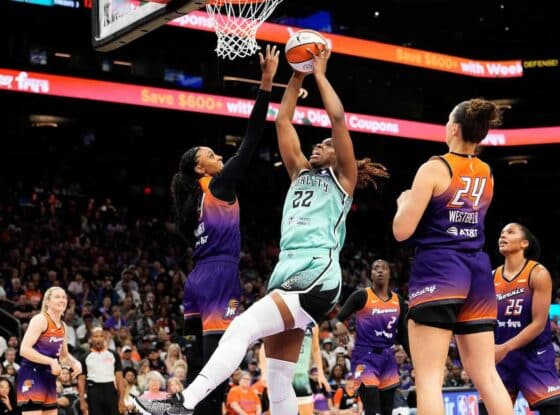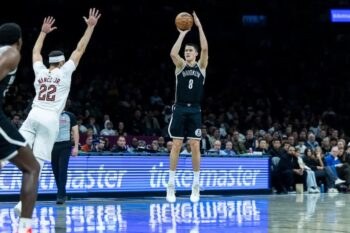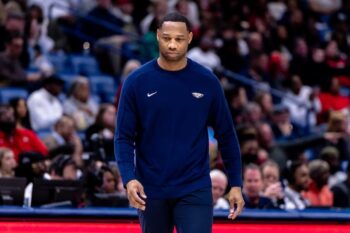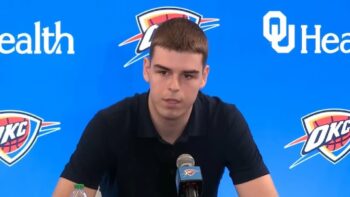NBA
4 Takeaways From Day 1 Of The WNBA Playoffs

After the first 44-game season in league history, the WNBA playoffs are finally here.
All four first-round series tipped off on an action-packed Sunday. While all four favorites won Game 1 — including the No. 5 seed New York Liberty, favored as the road team — we were left with much to discuss. The WNBA playoffs feature a best-of-threee format in the first round, meaning we have no time to waste. These were not feel-out games; four teams are suddenly facing elimination. Here are a few takeaways from the beginning of every series.
Are The Minnesota Lynx A Stoppable Force?
The Golden State Valkyries’ starting point guard, Veronica Burton, won the 2025 Most Improved Player award Monday afternoon. She was a slam-dunk candidate, the best player on the first expansion team to ever make the WNBA playoffs in its inaugural season.
Sunday afternoon, she proved why she was a shoo-in for the award during the first quarter between the No. 8 seed Valkyries and No. 1 seed Minnesota Lynx, the overwhelming favorite to win the WNBA title. Burton led Golden State to a 28-21 lead, hitting a couple threes off the dribble while controlling just about every offensive possession for her team, racking up five assists in the period.
Defensively, she was her usual self, playing the passing lanes to steal the ball twice and disrupt a few other Minnesota possessions. But Burton did not primarily defend her point guard counterpart in Courtney Williams, who frequently initiates with a ball-screen. Instead, Valkyries head coach Natalie Nakase put her best defender on Kayla McBride, a lights-out shooter whose nonstop movement greases the wheels of Minnesota’s offense.
It yielded strong results, at least initially:
telling that the Valks, largely, put VB on K-Mac instead of Courtney to start yesterday's game
just trying to limit the advantages K-Mac creates with screen navigation, and here, they do. VB locks and trails well, so Temi can recover to Phee, Kaila to CWill
great D pic.twitter.com/AciF5dlTur
— Lucas Kaplan (@LucasKaplan_) September 15, 2025
Tasked with stopping Minnesota’s well-oiled offense, plenty of opposing head coaches opt to switch most actions. It’s an attempt to cut off the Lynx’s ball-movement and side-to-side flow, and while it sounds nice in theory, they’ve seen it too often. Head coach Cheryl Reeve’s team capitalizes on the slightest moment of defensive confusion, slipping screens or faking handoffs to create open layups.
Golden State decided to put its best defender and screen navigator on McBride as part of an effort to limit such miscommunications. Lesser defenders went over screens on Williams and lived with one of the WNBA’s most frequent midrange shooters taking decent looks. Against Napheesa Collier, Golden State didn’t show early help, but rather tried to meet her at the rim to force difficult looks or late kick-out passes.
This is all easier said than done but it worked early. Now, Burton played the first 34 minutes of the game and when she needed a mini-breather by defending somebody else, McBride caused problems:
K-Mac is a tough guard man: pic.twitter.com/KULL1r87DW
— Lucas Kaplan (@LucasKaplan_) September 16, 2025
The historically great Lynx ultimately blew the expansion team Valkyries out, as expected. Golden State’s offense died early in the second quarter and never came back to life, allowing Minnesota plenty of early shot-clock opportunities. The Lynx also hit some tough shots and made some great individual plays as the game wore on, their home crowd getting rowdier after a surprising first quarter. It happens.
But the Lynx are always clinical, no matter what defenses try to do. It’s no coincidence they ran a play for McBride as soon as Burton moved off her, and it’s no coincidence Reeve went to this twirl action between McBride and Collier to open the second half:
Minnesota forces Burton to switch onto its superstar and from there, it’s lights out. No chance to double, no chance to switch back, just a pure bucket.
As expected, the WNBA’s greatest expansion team ever — the third-best defense in the league — came out swinging as huge underdogs. The Valkyries arrived in Minnesota with an admirable defensive game-plan. Perhaps, Minnesota’s next opponent will study that first-quarter tape closely. But in 2025, it feels like you can only contain the Lynx for a couple of minutes before the dam breaks.
Where Would The Atlanta Dream Be Without Naz Hillmon?
In Sunday’s second game, the No. 3 seed Atlanta Dream defeated the No. 6 seed Indiana Fever. The Fever, which have lost five players to season-ending injuries, including their top-three point guards, are just running out the clock. Maybe, Kelsey Mitchell and Aliyah Boston will be more competitive than expected against Atlanta. But this was supposed to be a contending year for Indiana that, starting with Caitlin Clark’s injury, never got off the ground.
On the Atlanta side, the Dream are a totally different team from the beginning of the season. Since the calendar flipped to August, bigs Brionna Jones and Brittney Griner have shared the floor for 13 minutes in total; the non-spacers were starting together up until then. But rookie head coach Karl Smesko has benched Griner, promoting Naz Hillmon to the starting lineup instead.
Atlanta won 15 of its final 18 games. We didn’t need much more evidence this was the right move but Sunday’s game provided it. If or when the Dream advance to the next round, they’ll face serious questions about how much Griner can play at all. She saw just eight minutes of action on Sunday, spending most of her time getting blown by in pick-and-roll defense…
But this section is about Hillmon. As a star forward at the University of Michigan, 91 percent of her shot attempts her senior year were either layups or hook shots, per Synergy. Even in 2024 with the Dream, layups and hooks accounted for 82 percent of her shots.
During the 2025 regular season, she shot 32.1 percent from deep on a healthy 7.7 attempts per 100 possessions. In a preposterous turn of events, Hillmon took over half of her shots from deep this year and that leap just about saved Atlanta’s season. She’s shooting often and well enough to garner some respect from defenses, which is really all her teammates need.
But it’s also allowed Hillmon to thrive all over the floor. Here are three smooth plays she made against Indiana on Sunday that make it look like she’s been playing on the perimeter her whole life:
Toward the end of the shot clock, she sets an impromptu flare screen to create an open three for Rhyne Howard. She nails one of her own off a classic Horns set. She flashes up to the wing to deliver a precise entry pass for a layup.
On the other end, Hillmon recorded a steal and three blocks, cementing a stat line of 16/9/3/1/3. Opponents respect her outside shot and know she’ll be covering ground on the other end. It was a fantastic playoff opener for Hillmon, who deserved nothing less than a nationally televised coming out party to put an exclamation point on her season.
The New York Liberty And Phoenix Mercury, Both Searching
In the most exciting game of the day, the No. 5 seed New York Liberty took down the No. 4 seed Phoenix Mercury in overtime. The only stain on the exciting finish was Breanna Stewart’s injury. Her left knee seemed to buckle as she went up for a layup during overtime. She yelped in pain and could only watch in tears from the sideline, as the Liberty finished out the win she led them to.
It was a terrible sight for any WNBA fan but especially New York fans; the team’s hopes of repeating as champions are cooked if Stewart’s injury is half as serious as it seemed. Now, it really didn’t help that star midseason acquisition Emma Meesseman was a minus-17 in her 13 minutes off the bench. Though she got unlucky on offense, missing some shots she regularly makes, the defensive end provided much trouble.
Meesseman could survive well enough guarding Natasha Mack, a traditional rim-running big that keeps her around the rim, but struggled mightily defending Kathryn Westbeld and DeWanna Bonner:
Emma struggled guarding spacers in the pick-and-pop…but can probably survive on Mack pic.twitter.com/oYTD1rwrXh
— Lucas Kaplan (@LucasKaplan_) September 16, 2025
Liberty head coach Sandy Brondello could turn to Kennedy Burke as Stewart’s primary replacement. But Burke had a brutal Game 1, shooting 0-of-4 with a few lowlights mixed in. Following Stewart’s injury, this was really the story for both teams: Where do they go?
Mack played just 19 minutes, doing more harm than good to Phoenix’s offense. Bonner played 31 minutes off the bench and shot well but was exposed by the end of the contest as New York played off her and capitalized on her defensive mistakes.
If Stewart is out for the series, the Mercury won’t need their depth to shine too brightly. Satou Sabally shot 2-of-17. Alyssa Thomas missed two free throws, air-balled a floater and missed a game-winning layup in the final two minutes of regulation:
oh my god Alyssa Thomas smokes an open layup for the WIN pic.twitter.com/e4Oqf4PK7R
— Lucas Kaplan (@LucasKaplan_) September 14, 2025
Even with dismal performances from their stars, the Mercury still should have won that game. Perhaps, that’s cause for a mini-celebration. Perhaps, the Liberty being able to back up Stewart with Meesseman is as well. But despite playing the most exciting game of the day, neither of these teams feel like true championship contenders after Game 1.
The Las Vegas Aces Feel Complete
A’ja Wilson is the best player in the world but she no longer has to carry the No. 2 seed Las Vegas Aces. Some of that is thanks to their defense, which midseason trade acquisition NaLyssa Smith is bolstering.
Smith spent the first three-and-a-half years of her WNBA career as a typical tweener, not capable of anchoring a defense as a lone big, not quite capable of spacing the floor next to a true center. But under head coach Becky Hammon, her role in Las Vegas in simple. Smith contains ball-handlers as they approach the rim and occasionally offers help on the block but is rarely tasked with guarding the league’s most talented wings.
She’s excelled with the Aces. Early in Game 1 against the No. 7 seed Seattle Storm, we saw why. On this play, she can just take up space as Brittney Sykes unsuccessfully eyes the paint, eventually allowing Jackie Young to jump a passing lane and lead a fast-break opportunity:
The Aces recorded 10 steals in Game 1, scoring 21 points off turnovers. Smith and the stability she provided inside was key to that; she also came up with two of Las Vegas’s six blocks. Smith isn’t a perfect big defender but she does just enough to let the other Aces, especially Wilson, help out.
Wilson, who led the home team with 29 points in its victory, has also been aided by a friendlier offensive environment over this historic 17-game win streak, which has extended into the playoffs.
circling back to this, per tracking data:
a'ja saw a second defender/double team on 10.3% of her touches last night, the fifth LOWEST rate in a game for her this season. https://t.co/Nw7KCx2pDu
— Nekias (Nuh-KY-us) Duncan (@NekiasNBA) September 15, 2025
Some of the Aces’ offensive improvement is natural progression throughout the season. Jewell Loyd has embraced her role as a bench gunner who mostly takes 3-pointers while Smith replacing offensive non-threat Kiah Stokes in the starting lineup has been a massive upgrade. On this play, Wilson is initially denied a catch but then flashes to the middle and — flanked by three capable shooters and an active offensive rebounder in Smith inside — has a clean one-on-one matchup:
to Nekias' point about A'ja having more space to operate. I know Seattle trusts Gabby, but where would they even double from here? pic.twitter.com/KC7iTJg3zt
— Lucas Kaplan (@LucasKaplan_) September 16, 2025
Even as the ball falls through the net, you can see Smith creep into offensive rebounding position, a much more effective use of a double-big lineup than Stokes, a 13 percent 3-point shooter, standing in the corner, begging to be ignored.
When the Aces traded a future first-round pick for Smith on June 30, it was seen as an overpay. Las Vegas was just 8-8 and gave up its last first-rounder until 2028 at the earliest, while Smith was averaging career-lows for the Dallas Wings. She is not the sole reason for the Aces’ uptick but her addition cannot be understated. It’s given Las Vegas a fully functional front-court. Since the trade, everything else has fallen into place.











